
If you want to give your Spathiphyllum Sensation optimal care so it can thrive, this is the right guide for you. From watering, light requirements, and fertilizing to soil and propagation, this guide has everything you need to be a responsible Spathiphyllum Sensation parent. Keep reading to get detailed information about growing this captivating plant.
| Botanical Name (Latin Name/Scientific Name): | Spathiphyllum Wallisii ‘Sensation’ |
| Common Name: | Peace Lily Sensation |
| Light: | medium light (750+ lux; 75 foot candles) |
| Watering: | once the top half of the soil dries out |
| Soil: | well-draining, chunky potting mix |
| Repotting: | once a year or when the roots come out of the drainage holes |
| Fertilizing: | with every watering with a high-nitrogen fertilizer |
| Temperature: | between 75°and 85°F (23° and 30°C) |
| Humidity: | 25% to 50%, but adapts well to any humidity |
| Toxicity for Pets: | Yes (mouth, tongue, and lips burning and irritation, excessive drooling, vomiting, difficulty swallowing) |
| Toxicity for Humans: | Yes (irritation to the lips, mouth and tongue, stomach upset, a skin rash or irritation) |
| Propagation: |
|
| Pruning: | prune dead or diseased growth or when you want the plant to branch out |
Spathiphyllum Sensation plant is a giant peace lily cultivar that can reach a height of 150cm to 180cm (4.9 to 5.9 feet). The huge leaves of this plant are dark green, glossy, and ribbed. Sensation Peace Lily is also noted for its large white flowers, 2-3 inches wide and 5-7 inches tall.
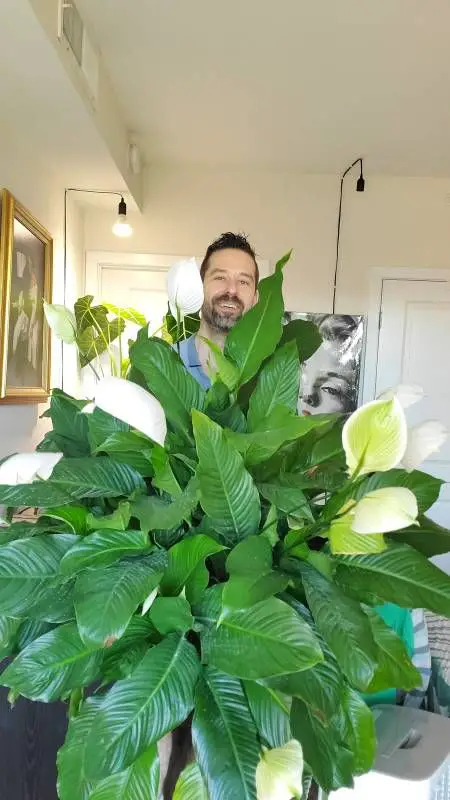
Sensation Peace Lily
Spathiphyllum Sensation Care
Spathiphyllum Sensation care isn’t too complicated. If you provide your Spathiphyllum Sensation Plant with enough light (more than 750 lux), adequate watering, and chunky and well-draining soil, it will flourish and reward you with lush foliage and vibrant blooms. Spathiphyllum Sensation Plant is the perfect houseplant for both rooky plant parents and those with more experience.
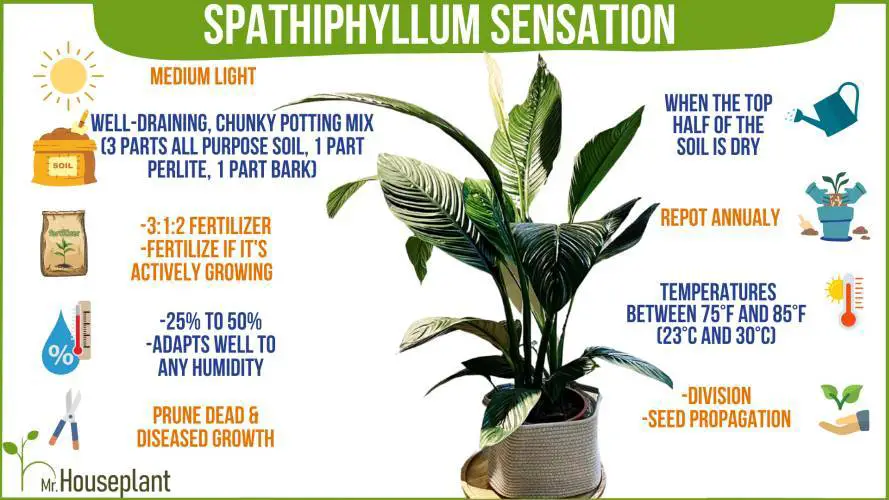
Follow these care steps for your Spathiphyllum Sensation plant. Photo of the plant by: izzie-izzie
Sensation Peace Lily Light Requirements
| Minimal amount of light: | 750+ lux (75+ FC) |
| Optimal amount of light: | 3,000+ lux (300+ FC) |
| Direct sun tolerance: | 1-2 hours of early morning or late afternoon direct sun |
| Category: | Medium light |
Peace Lily Sensation grows best in bright indirect light (over 3,000 lux / 300+ foot candles). Since Peace Lily Sensation is an understory plant in its native habitat, it is used to low light and medium light conditions and it can tolerate medium and low light levels. However, it will not thrive in medium light and it may fail to flower.
Peace Lily Sensation grows well in bright light, but it doesn’t tolerate long exposure to direct sunlight. Since prolonged exposure to direct sunlight can damage its leaves and affect photosynthesis, it’s best to expose it only briefly to early morning or late afternoon direct sun (no more than 1-2 hours).
Water Needs
For Sensation Peace Lily watering let the top half of the soil dry out before watering. The standard way to assess if your Sensation Peace Lily is thirsty is to use a chopstick. Take a chopstick and stick it all the way to the bottom of the pot. Take it out and if the top half comes out completely dry, with no soil clinging to it, it’s time to water your Sensation Peace Lily.

Dirty chopstick means to wait more before watering. Once the top half of the chopstick is clean and dry it’s time to water the plant. Photo of the plant by: Ablazam
Humidity Needs
Optimal humidity levels for Spathiphyllum Sensation are between 25% and 50%. However, this plant can adapt well to any humidity level.
Temperature Requirements
The Spathiphyllum Sensation thrives in warm temperatures between 75° and 85°F (23° and 30°C). Whereas other tropical plants get visible leaf damage at 52°F (11°C), Peace Lilies will only experience slower growth. Exposure to temperatures below 45°F (7°C) will result in leaf damage. For some Peace Lilies varieties, such a low temperature can be fatal. Since your plant is inside your home or office, the room temperature will suit it just fine.
Fertilizing
Fertilize Spathiphyllum Sensation during active growing season with every watering using a liquid fertilizer with a 3:1:2 NPK ratio. If you only fertilize when your plant is actively growing, it will be able to absorb and utilize all nutrients and minerals. Otherwise, the minerals will accumulate in the soil, and the plant won’t be able to use them. This can lead to root damage and subsequently leaf damage.
Always make sure to carefully follow the instructions written on the label, as overfertilizing can damage your Spathiphyllum Sensation.
Soil
Spathiphyllum Sensation will grow well in a well-draining, chunky potting mix. You can make it by mixing 3 parts of store-bought potting soil with 1 part perlite and 1 part bark. It’s advisable to use chunky amendments with larger particles as this will create macro pores that contain oxygen. Adequate soil aeration is vital for root health and it helps keep fungal diseases at bay.
Repotting
To repot your Spathiphyllum Sensation take the following steps:
- Gently take the plant out of its pot
- Loosen the rootball carefully
- Inspect the rootball
- If you notice any dead, smelly, mushy, or diseased roots, cut them off
- Fill up ⅓ of the new pot with fresh soil (mix 3 parts soil with 1 part perlite and 1 part bark. Pots with drainage holes are optimal, because the excess water can be expelled)
- Place your Sensation Peace Lily into its new pot
- Fill up the pot with fresh soil
- Gently press the soil around your Sensation Peace Lily
- Wait for the soil to dry out fully before you water
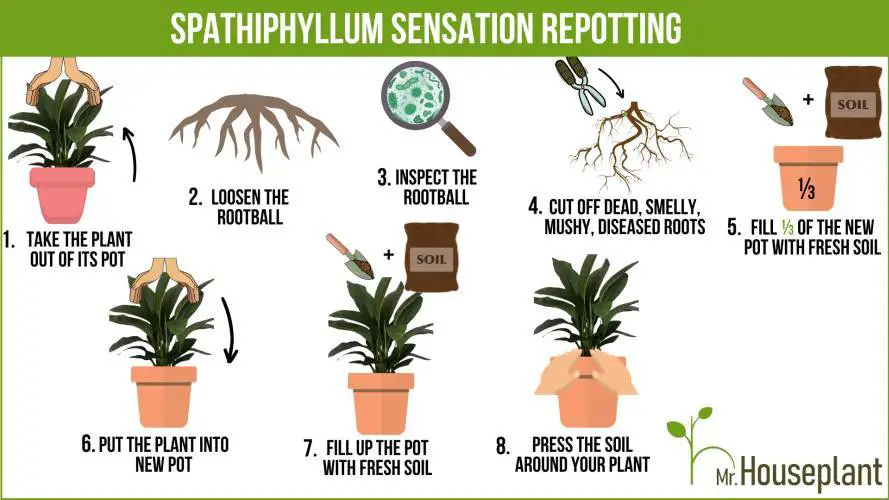
Follow these steps to repot the Sensation Peace Lily plant. Photo of the plant: Ablazam
You should repot your plant if it overgrows its container. You will know this if you see the plant’s roots coming out of the drainage holes. This is a sign that your Spathiphyllum Sensation needs to be repotted into a one-size larger container so it has room for growth. Even if it doesn’t overgrow its container, you should repot it once a year so it can get nutrients from fresh soil and continue growing in non-compacted soil.
Here is a video of Sensation Peace Lily repotting:
Toxicity To Humans
Peace Lilies are toxic to humans. California Poison Control System (CPCS) states that this plant contains oxalate crystals that may cause lip, mouth, and tongue irritation. Sometimes breathing problems and swelling in the throat are also possible.
Ann King Filmer, Ph.D. Plant Scientist from the University of California, in the publication “Safe and Poisonous Garden Plants” from October 2012 confirms that Peace Lily can also cause stomach upset, and a skin rash or irritation.
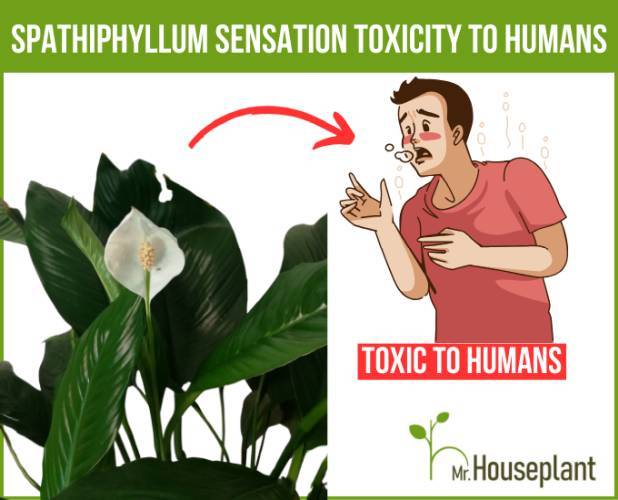
Sensation Peace Lily plant is toxic to humans
Toxicity To Pets
Peace Lilies are toxic to pets. If your pet swallowed a part of a Peace Lily it can cause oral irritation, intense mouth, tongue, and lips burning and irritation, excessive drooling, vomiting, and difficulty swallowing according to the American Society For The Prevention Of Cruelty To Animals.
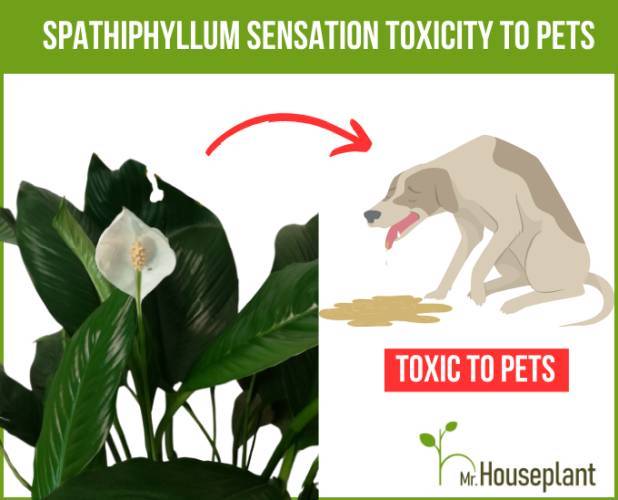
Sensation Peace Lily plant is toxic to pets
Pruning
Prune your Peace Lily when the flowers have faded, when the leaves turn dry and brown, and when you see brown leaf tips. Use sterilized, sharp pruning shears to prune your plants. To remove dry leaves or faded flowers, cut them off at the base. Cut off the stalks as close to the bottom as you can.
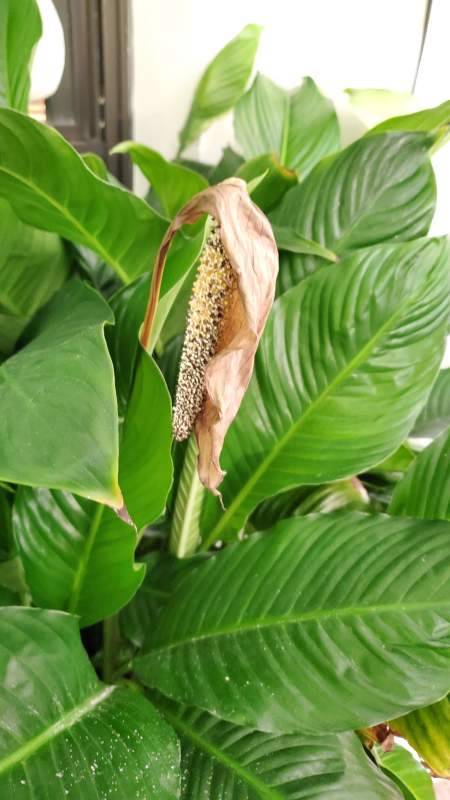
A dried-out Peace Lily Sensation flower
Flowering
Spathiphyllum Sensation Plant can flower several times a year, if it’s provided with sufficient light. The flowers are white, 2-3 inches wide and 5-7 inches tall. To help your peace lily plant produce flowers, provide it light over 3,000 lux (300 FC). For more details on peace lily blooming, check out my detailed article on the topic.
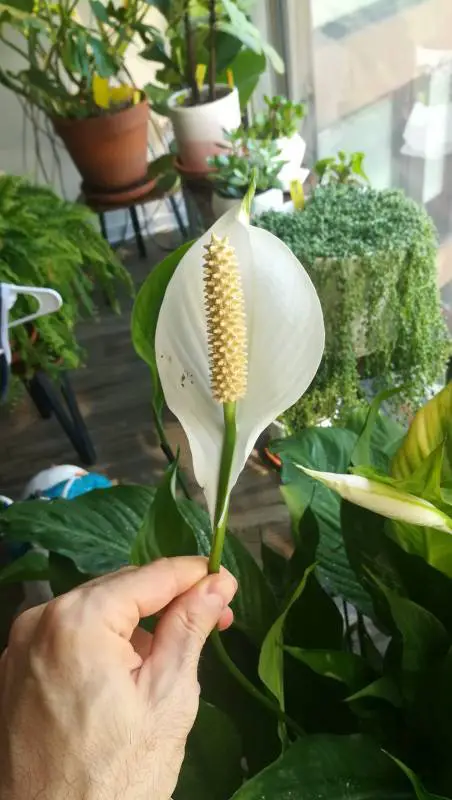
Peace Lily Sensation blooming
Propagation
Spathiphyllum Sensation can be propagated easily via division and seed propagation. You cannot propagate a Peace Lily by taking a leaf cuttings. Here is how to propagate Peace Lily Sensation via division:
- Remove the plant from its pot and loosen the soil around the roots. Don’t worry if you cut off some of the roots in the process.
- Identify where the roots of 2 clumps of peace lily leaves connect.
- Separate the two plants/clumps. With smaller plants, you might be able to pull the roots apart by hand, but with larger plants with thicker roots, you will need to cut them with sterilized pruning shears.
- Take two new pots and fill one-third of the pots with fresh potting soil.
- Put the divided Peace Lilies in the previously prepared pots.
- Fill the new pots with soil.
- Water the plants.
- Put new Peace Lilies in a spot with bright, indirect light.
Here is a video of Peace Lily Sensation seed propagation:
Pests
Spathiphyllum Sensation can be infested by fungus gnats, spider mites, mealy bugs, scales, thrips and whiteflies. In cases of mild infestation you can treat your Spathiphyllum Sensation plant with rubbing alcohol, insecticidal soap, or neem oil. In cases of severe infestations, systemic insecticides can be used.
Rubbing alcohol is best against mealybugs. Make a solution consisting of 1 part alcohol and 7 parts water. Spray the plant with this solution making sure that you don’t miss any nooks and crannies since pests like to hide there. Test first on 1 leaf and wait for 24 hours before spraying the whole plant, to make sure there is no damage on the leaf.
You can use insecticidal soap against aphids and mites. Spray the plant thoroughly, paying special attention to the underside of the leaves. You will usually have to repeat the process a couple of times every 4-7 days, according to the instructions.
In case you want to treat your Peace Lily Sensation with neem oil, mix 5 drops of pure 100% neem oil with 5 drops of dish soap in 16oz of water. Use a spray bottle to spray the plant with this solution. Keep the plant out of the direct sun for a few hours after the application, as the direct sun can cause leaf damage after neem oil application.
Common Problems
Yellow Leaves
Yellow leaves on your Spathiphyllum Sensation Peace Lily happen due to one of the following: regular senescence (leaf loss), insufficient moisture, overwatering, a nutrient deficiency, or pests. You can diagnose yellow leaves based on the way the leaves are yellowing and the care the plant is getting.
If you know your Sensation Peace Lily is getting sufficient light and the watering is correct, it’s likely due to regular loss of older leaves, pests, or nutrient deficiency. If the leaves are yellow and wilted, it is likely that the plant is either overwatered or underwatered. If the leaves have fading yellowing on the edges, you likely have pests.
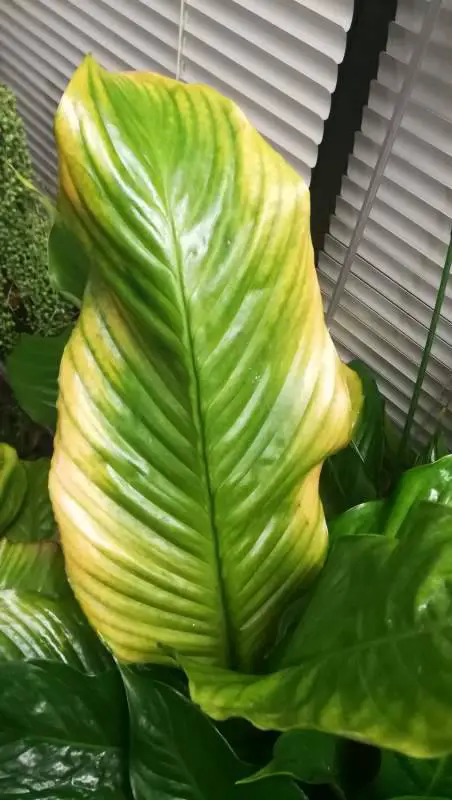
Spider mite damage on Peace Lily Sensation
It’s also possible that your plant cannot support any more leaves due to the amount of light it’s receiving. Once it reaches the maximum number of leaves with the current amount of light, lower leaves will start yellowing and dying. This would be considered normal leaf senescence.
Diagnosing yellow leaves on the Spathiphyllum Sensation is a complex issue. It’s important to always look at the overall environment the plant is in (light, watering, fertilizing, etc.) and the care Peace Lily is receiving in order to diagnose properly. If you have any doubts about how to take care of your beautiful Peace Lily, feel free to book a consultation with me.
Yellow leaves on your Spathiphyllum Sensation Peace Lily happen due to one of the following: regular senescence (leaf loss), insufficient moisture, overwatering, a nutrient deficiency, or pests. You can diagnose yellow leaves based on the way the leaves are yellowing and the care the plant is getting.
If you know your Sensation Peace Lily is getting sufficient light and the watering is correct, it’s likely due to regular loss of older leaves, pests, or nutrient deficiency. If the leaves are yellow and wilted, it is likely that the plant is either overwatered or underwatered. If the leaves have fading yellowing on the edges, you likely have pests.
Brown Leaf Tips
Brown leaf tips on your Spathiphyllum Sensation Peace Lily are due to one of four reasons: too little water, too much fertilizer, low humidity, or soil compaction. Peace Lilies prefer getting enough water, so if they don’t get it the leaves will start to turn brown and wilt. Make sure to water your houseplants regularly.
If you are using too much fertilizer, the salts in the fertilizer can build up and burn the tips of the leaves.
If you have very low humidity (under 20%), use a humidifier near the plant to increase humidity.
If the soil is compacted, this can also cause brown tips. Do a full repot of your plant by removing all old soil and replacing it with fresh new soil.
Before trying to solve brown tips problem, know that brown tips are not a problem, they are just an aesthetic issue. Feel free to cut them off and enjoy the beauty of your plant. Plants are not perfect in nature, they shouldn’t be perfect in our indoor garden.
FAQ
How Big Do Spathiphyllum Sensation Get?
Spathiphyllum Sensation can grow to a height of 1.5 to 1.8 meters. It will take time to grow to that height from a young plant and it will grow that big if you provide it with proper light, watering and nutrition.
What Is The Difference Between Spathiphyllum Sensation And Peace Lily?
Spathiphyllum Sensation is the largest cultivar of Spathiphyllum and produces large, deeply ribbed leaves. It can grow up to a height of 180 cm (5.9 feet).
Conclusion
Spathiphyllum Sensation is an easy-to-grow plant if you meet its care requirements. If you apply all the tips and trick from this care guide, you will certainly be a proud plant parent of a lush and healthy Spathiphyllum Sensation plant.
Yours Truly,


Related Posts
Sansevieria Black Gold (Snake Plant Care GUIDE!)
Alocasia Stingray Care
Peperomia Verticillata ‘Red Log’